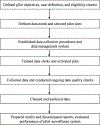Piloting a hospital-based road traffic injury surveillance system in Nairobi County, Kenya, 2018-2019
- PMID: 36925372
- PMCID: PMC10599333
- DOI: 10.1016/j.injury.2023.02.051
Piloting a hospital-based road traffic injury surveillance system in Nairobi County, Kenya, 2018-2019
Abstract
Background: Kenya's estimated road traffic injury (RTI) death rate is 27.8/100,000 population, which is 1.5 times the global rate. Some RTI data are collected in Kenya; however, a systematic and integrated surveillance system does not exist. Therefore, we adopted and modified the World Health Organization's injury surveillance guidelines to pilot a hospital-based RTI surveillance system in Nairobi County, Kenya.
Methods: We prospectively documented all RTI cases presenting at two public trauma hospitals in Nairobi County from October 2018-April 2019. RTI cases were defined as injuries involving ≥1 moving vehicles on public roads. Demographics, injury circumstances, and outcome information were collected using standardized case report forms. The Kampala Trauma Score (KTS) was used to assess injury severity. RTI cases were characterized with descriptive statistics.
Results: Of the 1,840 RTI cases reported during the seven-month period, 73.2% were male. The median age was 29.8 years (range 1-89 years). Forty percent (n = 740) were taken to the hospital by bystanders. Median time for hospital arrival was 77 min. Pedestrians constituted 54.1% (n = 995) of cases. Of 400 motorcyclists, 48.0% lacked helmets. Similarly, 65.7% of bicyclists (23/35) lacked helmets. Among 386 motor vehicle occupants, 59.6% were not using seat belts (19.9% unknown). Seven percent of cases (n = 129) reported alcohol use (49.0% unknown), and 8.8% (n = 161) reported mobile phone use (59.7% unknown). Eleven percent of cases (n = 199) were severely injured (KTS <11), and 220 died.
Conclusion: We demonstrated feasibility of a hospital-based RTI surveillance system in Nairobi County. Integrating information from crash scenes and hospitals can guide prevention.
Keywords: Helmets; Kampala Trauma Score; Kenya; Motor vehicle crashes; Motorcyclists; Pedestrians; Public health surveillance; Road traffic crashes; Road traffic injury; Seat belts.
Copyright © 2023 Elsevier Ltd. All rights reserved.
Conflict of interest statement
Declaration of Competing Interest Valerian Mwenda reports financial support was provided by Centers for Disease Control and Prevention Center for Global Health.
Figures


References
-
- World Health Organization. Global status report on road safety 2018. https://www.who.int/publications/i/item/9789241565684 (accessed 14 September 2021).
-
- Yannis G, Nikolaou D, Laiou A, et al. Vulnerable road users: cross-cultural perspectives on performance and attitudes. IATSS Res 2020;44(3):220–9. doi:10.1016/j.iatssr.2020.08.006. - DOI
-
- World Health Organization. Road traffic injuries. https://www.who.int/news-room/fact-sheets/detail/road-traffic-injuries (accessed 30 June 2022).
Grants and funding
LinkOut - more resources
Full Text Sources
Miscellaneous

